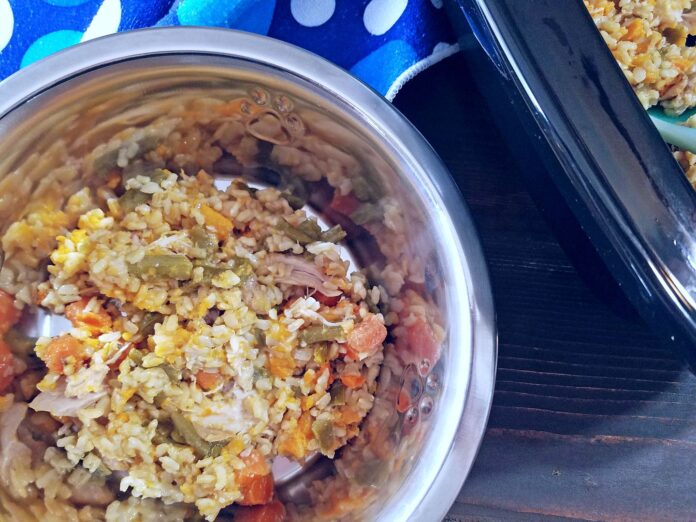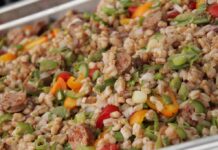As a dedicated pet parent, making homemade dog food with chicken is one of the best ways to ensure your furry friend gets the nutrition they need. This comprehensive guide will help you create nutritious and delicious meals that’ll make your pup’s tail wag with joy!
Why Choose Homemade Dog Food?
Before diving into our recipe, it’s important to understand why many pet owners are switching to homemade dog food. The control over ingredients and quality makes it an attractive option for those wanting the best for their four-legged friends.
Pet like boss experts suggest that homemade meals can provide better nutrition when properly balanced. Plus, you’ll know exactly what’s going into your dog’s bowl!
Essential Ingredients for Homemade Dog Food with Chicken
The Base Protein: Chicken
- 3 pounds of boneless, skinless chicken breasts
- Rich in lean protein for muscle maintenance
- Easy to digest and generally well-tolerated
Healthy Carbohydrates
- 2 cups brown rice
- 1 cup sweet potatoes
- 1 cup regular potatoes
Nutrient-Rich Vegetables
- 2 cups mixed frozen vegetables (carrots, peas, green beans)
- 1 cup spinach
- 1/2 cup chopped celery
Step-by-Step Cooking Instructions
-
Prep the Chicken
- Cut chicken into small, bite-sized pieces
- Boil in water until thoroughly cooked
- Drain and set aside
-
Cook the Carbs
- Prepare brown rice according to package instructions
- Cube and boil potatoes until tender
-
Vegetable Preparation
- Steam frozen vegetables until tender
- Chop fresh spinach and celery
-
Combine Everything
- Mix all ingredients in a large bowl
- Let cool before serving
Storage and Serving Tips
When making homemade dog food with chicken, proper storage is crucial:- Store portions in airtight containers- Keep in refrigerator for up to 5 days- Freeze extra portions for up to 3 months
Important Nutritional Considerations
Creating balanced homemade dog food with chicken requires attention to nutritional needs:
-
Calcium Supplement
- Add 1 tablespoon ground eggshell per batch
- Or use commercial calcium supplement
-
Essential Fatty Acids
- Include 1 tablespoon fish oil
- Or add flaxseed oil
Tips for Transitioning to Homemade Food
When introducing homemade dog food with chicken, follow these steps:1. Start gradually mixing with current food2. Increase homemade portion over 7-10 days3. Monitor your dog’s reaction4. Consult your vet if issues arise
Common Mistakes to Avoid
- Skipping supplements
- Using unsafe ingredients
- Not measuring portions
- Forgetting to include variety
Recipe Variations and Add-ins
Spice up your basic homemade dog food with chicken recipe with these safe additions:- Pumpkin puree- Plain yogurt- Eggs- Apple slices (no seeds)
Health Benefits of Homemade Dog Food
-
Better Digestion
- Fresh ingredients are easier to process
- Fewer artificial preservatives
-
Weight Management
- Control portion sizes
- Adjust ingredients as needed
-
Allergy Management
- Know exactly what’s in their food
- Easily eliminate problem ingredients
-
Improved Energy
- Better quality ingredients
- More natural nutrients
Cost Considerations
While homemade food might seem expensive initially, consider:- Bulk buying ingredients- Batch cooking- Potential vet savings from better nutrition- Peace of mind from quality control
When to Consult Your Veterinarian
Always check with your vet:- Before starting homemade diet- If your dog has health conditions- When adjusting portions- If you notice any changes in behavior
Making homemade dog food with chicken can be a rewarding experience for both you and your furry friend. With proper planning and attention to nutritional needs, you can provide your dog with healthy, delicious meals they’ll love.
Remember to:- Follow recipes carefully- Include all necessary supplements- Monitor your dog’s health- Make gradual transitions- Store food properly
By following this guide, you’ll be well on your way to becoming an expert at preparing nutritious homemade meals for your beloved pet. Happy cooking!
Note: This recipe provides a basic framework. Always consult with your veterinarian about your specific dog’s nutritional needs, as they may vary based on age, size, and health conditions.












